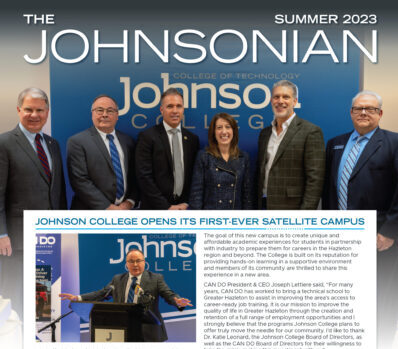Johnson College proudly announces a remarkable milestone as it experiences its sixth consecutive year of record enrollment, with overall student numbers surging by an impressive 32% year over year. This unprecedented growth underscores the increasing interest and value in the College’s hands-on, industry-immersed, career-focused education across all its 18 programs.
“A sixth consecutive year of record enrollment is a testament to the dedication of our faculty and staff, the quality of our programs, and the increasing recognition of the value of a Johnson College hands-on, technical education.” Said Bill Burke, Vice President of Enrollment and Student Affairs at Johnson College, “The College’s growth at both of its campuses is not only a sign of its success but also a promising indicator of the future of technical education and its role in shaping our future skilled workforce.”
Johnson College offers a range of programs designed to meet the evolving needs of today’s industries. With state-of-the-art classrooms and labs and strong industry partnerships, students have access to cutting-edge resources and opportunities for real-world experience. The College’s focus on technical education ensures that graduates are not only knowledgeable but also adept at applying their skills to help build strong regional and national industries.
“We’re excited to welcome such a diverse and talented group of students into all our programs,” said Dr. Katie Pittelli, President & CEO of Johnson College. “As industry demands continue to evolve, Johnson College will continue to answer the call for our highly skilled technicians and technologists. With the growth of high-demand technical careers showing no signs of slowing, we will continue to work with our employer partners to ensure our students are equipped for career success and ready to meet the future head-on.”
The College’s commitment to its students and industry partners is evident in these exceptional enrollment increases. Programs are preparing students for industries experiencing faster-than-average national 10-year growth trends, per the U.S. Bureau of Labor Statistics. Notably, these include Veterinary Nursing (21% increase), Medical Equipment Repair (13% increase), and HVAC and Electrical Construction (6% increase) industries. Some Johnson College enrollment highlights include:
- Heating, Ventilation, and Air Conditioning Technology: Enrollment has risen by 10% from the previous year, reflecting the growing need for skilled professionals in this essential field.
- Electrical Construction Technology: This program has seen a 35% increase, highlighting the burgeoning demand for highly trained residential and commercial electricians, and industrial engineering technicians.
- Architectural Drafting and Design Technology: Enrollment has surged by 57%, marking one of the most significant growth areas driven by the expanding architectural and design industry.
- Aviation Technology: In its second year, this program has experienced a 32% increase in enrollment, demonstrating the clear demand for well-trained aviation technicians in an industry facing a shrinking workforce.
- Biomedical Equipment Technology: The 43% rise in enrollment reflects the heightened interest in the Healthcare Technology Management industry.
- Electronic Engineering Technology: This program’s 17% growth demonstrates ongoing enthusiasm for careers in electronic instrumentation and related fields.
- Veterinary Nursing: A 56% increase in enrollment highlights the growing passion for animal care and veterinary sciences.
- Welding Fabrication & Manufacturing Technology: Enrollment has risen by 28%, signaling continued robust interest in skilled trades and manufacturing.
Additionally, Johnson College has seen a notable increase year-to-year in enrollment from various age groups:
- Directly from high school: 11%
- Ages 19-21: 35%
- Ages 22+: 23%
- Ages 25+: 13%
Johnson College is excited to welcome a diverse group of students this academic year and looks forward to continuing its commitment to being the leader in hands-on, industry-focused education in northeastern Pennsylvania.









